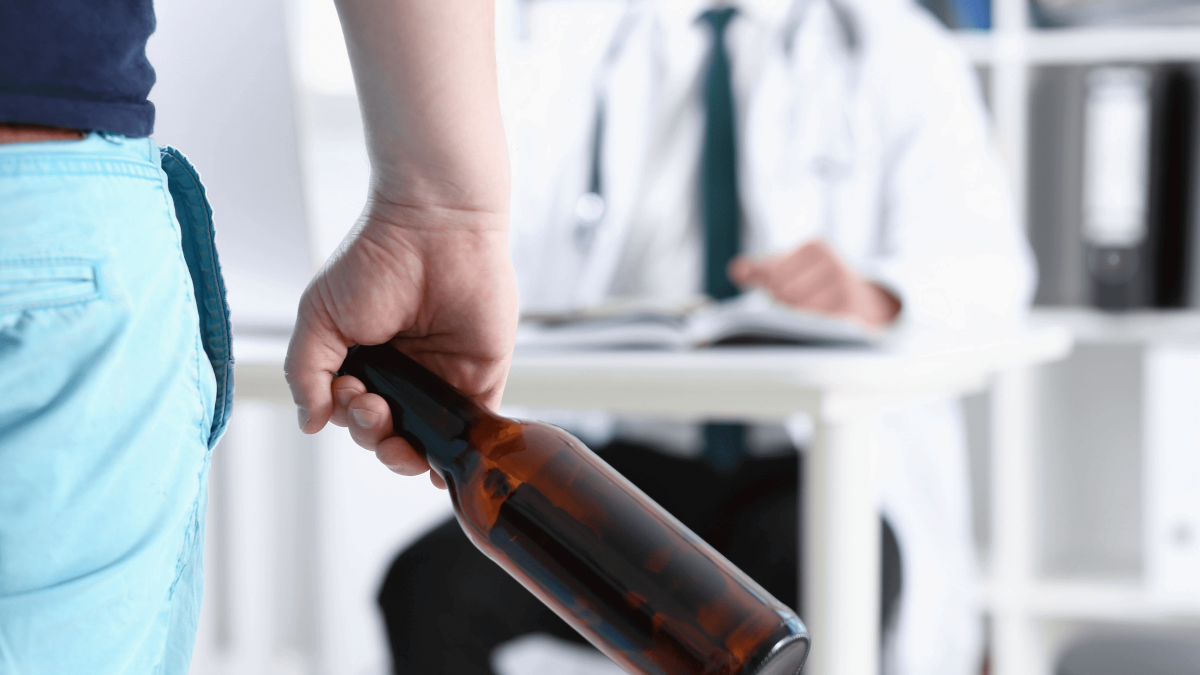Quit Drinking Cold Turkey or Stop Gradually?

About 14 million American adults suffer from alcohol use disorder (AUD), according to the National Institute on Alcohol Abuse and Alcoholism. Alcoholism is a chronic disease that impacts both the addicted one and those around them. Meanwhile, 1 in 10 children lives with an alcohol-dependent parent.
The urgent need to address this disease is vital, however, some people may wonder whether it is safer for the individual to taper off their alcohol consumption gradually or if it is better to stop drinking "cold-turkey" (all at once). Surprisingly, it is safer for them to gradually reduce the amount of alcohol they drink than to stop drinking cold turkey, since there can be serious side effects, including death, when abruptly stopping drinking.
The Dangers of Quitting Cold Turkey
When someone with a drinking problem decides to stop drinking it is an ultimately a positive life choice. However, it is crucial to deal with alcohol use disorder in a safe way. Quitting cold turkey may lead to very dangerous consequences.
As a result of chronic alcohol abuse, the body adapts to the constant presence of alcohol. As a depressant, alcohol slows down brain and nervous system functions. When alcohol isn't present, withdrawal symptoms may occur, which requires the central nervous system to learn to adapt again.
When withdrawing from alcohol, individuals may face various difficulties as their body works to restore its equilibrium. These illnesses range in intensity and can become quite severe. Referred to as "alcohol withdrawal syndrome" (AWS), they may include shaking, headache, tachycardia, heightened blood pressure, unease, and delirium tremens (DT). The latter is potentially life-threatening and includes manifestations like trembling, projectile vomiting, and disorientation. Symptoms of DT can be:
- Seizures
- Hallucinations
- Confusion
- Sensitivity to light
- Nausea
When someone has previously experienced alcohol withdrawal, drinks heavily, or has struggled with alcohol addiction for more than ten years, they are more likely to develop DTs.
AWS and DT can also cause physical issues, such as:
- physical trauma due to seizures
- metabolic issues
- low electrolyte levels
- cardiac complications, such as arrhythmias and sudden death resulting from a heart attack
- muscle weakness, coma, and the reduction or stoppage of normal breathing functions due to low levels of phosphate (hypophosphatemia)
When you abruptly stop drinking alcohol, you can develop Ketoacidosis. This happens because of how alcohol affects the pancreas' ability to produce insulin. Symptoms of Ketoacidosis include excessive thirst, fatigue, frequent urination, and vomiting.
What Is A Typical Drink?
Not all alcoholic drinks are the same. For example, 5 ounces of wine contain 12% alcohol, while 12 ounces of most beers contain 5% alcohol. There is one serving of alcohol in each of the following:
- 12 ounces of regular beer is 5%
- 8-9 ounces of malt alcohol is 7%
- 5 ounces of wine is 12%
- 1.5 ounce glass of distilled spirits (gin, rum, tequila, vodka, whiskey, etc.) contains 40% alcohol
The Process of Tapering Off Alcohol Consumption
Although tapering off drinking may still result in withdrawal symptoms, they will be less severe than quitting all at once. As long as the amount consumed does not decrease, changing to another form of alcohol will not improve withdrawal outcomes. It can be tough for a person to reduce their drinking. They may try cutting back or switch to an alternative drink, but triggers that urge them to drink can make it hard to stick to the path toward sobriety. What's more, without support, making the transition is even harder. Those who have been consuming heavily may encounter withdrawal symptoms from even a small decrease in their alcohol consumption.
Medical detox can be the most beneficial option for someone with AUD. Not only is it more effective, but it is also safer to stop drinking under the caring supervision of medical professionals.
Safely Withdrawing From Alcohol
In a medical detox facility or program, the detox team monitors the individual as their alcohol consumption decreases and their body removes all the toxins associated with alcohol. During the detox process, medical professionals watch vital signs closely. Fluids are administered to prevent dehydration, and balanced meals are provided to promote mental health and overall well-being. These components work together to reduce withdrawal symptoms and ensure safety in the withdrawal process. The duration of a typical detox program is generally five to seven days, though this can vary based on individual needs and alcohol dependence.
Health Consequences of Alcoholism
There are many factors can affect a person's well-being when they drink excessively. People who drink heavily are at greater risk of developing liver diseases, including hepatic steatosis (increased fat in the liver), alcoholic hepatitis (liver inflammation), and cirrhosis (irreversible scarring and destruction).
- Heavy or excessive alcohol consumption over time can have the following physical consequences:
- Digestive problems
- Heart issues
- Complications linked to diabetes
- Erectile dysfunction
- Menstrual disruptions
- Eye problems
- Congenital disabilities
- Bone damage
- Neurological complications
- Weakened immune system
- Increased risk for cancer
- Interactions with other medications
AUD Treatment Options
Each individual's alcohol use disorder needs and situation must be addressed during treatment. There are, however, certain common approaches that are used to help individuals stop drinking safely and effectively. Behavioral therapy, medications, and support groups are just a few examples.
In behavioral treatment, the goal is to change the behaviors that contributed to excessive drinking. Cognitive behavioral therapy (CBT) and motivational enhancement therapy (MET) are two popular options. CBT helps a person identify the triggers that contribute to alcohol abuse and develop new coping skills. To strengthen a person's motivation to stop drinking, MET identifies the advantages and disadvantages of treatment.
There have been three medications approved by the FDA for treating AUD to date: disulfiram, naltrexone, and acamprosate. None of these medications are addictive, but they are not cures. Instead, they can cause unpleasant nausea when someone drinks (disulfiram), or they can block the brain's receptors that make a person feel good when they drink (naltrexone). Finally, acamprosate reduces alcohol cravings.
As a final treatment for AUD, 12-step groups provide peer support and guidance. Alcoholics Anonymous (AA) is the most well-known 12 step organization, but there are many other options.
AUD and relapse
It is common for alcoholism to relapse during recovery, as it is a chronic disease. Like any chronic disease, alcoholism cannot be cured, but rather treated. Relapses are often a sign that a treatment program has become ineffective and needs to be changed.
If a relapse occurs, individuals shouldn't feel ashamed; instead, they should stop drinking and seek help as soon as possible. The NIAAA estimates that 90% of people with AUD relapse at least once during the first four years of recovery.
The more someone understands the stressors that can lead them to drink, the more prepared they will be to address these concerns. Talking to a therapist can help address potential triggers that caused their relapse and prepare them for challenges that might be around the corner. And as always, the support from peers, friends, and family is essential to continuing recovery.
In order to prevent future relapses, anyone who relapses is encouraged to work with a therapist to develop a new plan. The process should include examining triggers, both old and possibly newly developed ones, finding more effective coping techniques, and seeking out supportive people in their life that they can reach out to in the future.
Is Someone You Know Struggling With AUD?
Alcoholism and how it shows up in life of someone who is struggling is different from the next. In the past year, if an individual could answer yes to two or more of the following questions, they may have a drinking problem.
- Have they tried to cut down or stop drinking, but failed?
- Do they feel a strong urge to drink?
- Have they continued to drink despite trouble with family or friends?
- Has drinking, or being sick from drinking, regularly affected their family life, job, or school?
- Do they spend a lot of time drinking or recovering from drinking?
- In order to drink, have they given up or reduced their favorite activities?
- Did they find themselves in dangerous situations while drinking or after drinking, such as driving drunk or having unsafe sex?
- To feel the effects of the alcohol, did they have to drink more and more?
- Have they continued to drink despite feeling depressed or anxious or experiencing physical health issues?
- When the alcohol wore off, did they experience withdrawal symptoms like trouble sleeping, shakiness, irritability, anxiety, depression, restlessness, nausea, and sweating?
Alcohol Addiction Treatment Without Judgment
The process of overcoming alcohol use disorder can be challenging and ongoing. Alcohol addiction is not caused by a lack of willpower. Individuals can overcome an addiction to alcohol faster if they stop drinking safely by seeking professional guidance and treatment from a reputable addiction treatment program. People in recovery can benefit from the help of addiction specialists in understanding their best options for obtaining sobriety. When dealing with alcohol withdrawal, this is particularly important, since going cold turkey alone can have fatal consequences.
At Redemption Addiction Treatment Center, recovering individuals created our facility. We understand that letting go of alcohol takes time. We not only provide and use clinical and medical approaches and techniques, we also provide individuals with the empathy, love, understanding, compassion, direction, guidance, and treatment they need in order to recover. To learn more, please contact us today.




